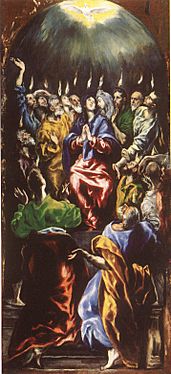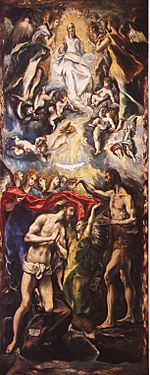Doña María de Aragón Altarpiece facts for kids
The Doña María de Aragón Altarpiece was a large artwork painted by El Greco between 1596 and 1599. It was made for a chapel in a college in Madrid, Spain. This college was also known as the Colegio de doña María de Aragón.
Later, the college changed, and the altarpiece was taken apart. For a long time, people wondered which paintings were part of it. Experts now agree it had six large paintings and one smaller one that is now lost. Five of the six large paintings are kept at the Museo del Prado in Madrid. The sixth painting is in the National Museum of Art of Romania in Bucharest.
Contents
What Was the Altarpiece Like?
An altarpiece is a special artwork placed behind the altar in a church. El Greco's altarpiece for Doña María de Aragón was very big. It was made up of several paintings arranged together.
Because the altarpiece was taken apart long ago, there are no clear old papers describing it. This made it hard for art historians to know exactly how it looked. They had to guess which paintings belonged to it and how they were arranged.
In 1814, a list was found that mentioned seven paintings by El Greco from the main altar of the college. This helped experts understand that the altarpiece likely had seven parts. It is thought to have been arranged in two main levels, with a smaller painting at the very top.
The paintings likely told a story about important moments in Christian belief. For example, the lower level might have shown the start of a story, and the upper level the most important part. This arrangement helped people understand the religious message of the artwork.
The Paintings Today
El Greco painted these artworks in a very unique style. He often used themes he had painted before, but he made them new and exciting. His paintings from this time show his strong feelings and a very personal way of seeing the world.
He often made the scenes feel crowded, with figures stretching upwards. He used unusual light to make the figures look dreamlike. The colors he chose were often cool and bright, with strong contrasts. This style is a key part of his later work.
Names, Dimensions, and Museums
-
Pentecost
1597-1600
275 x 127 cm
Museo del Prado (Madrid) -
Adoration of Shepherds
1597-1600
364 x 137 cm
National Museum of Art of Romania (Bucharest) -
Annunciation
1597-1600
315 x 174 cm
Museo del Prado (Madrid) -
Baptism of Christ
1597-1600
315 x 144 cm
Museo del Prado (Madrid)
Images for kids
See also
 In Spanish: Retablo de doña María de Aragón para niños
In Spanish: Retablo de doña María de Aragón para niños







